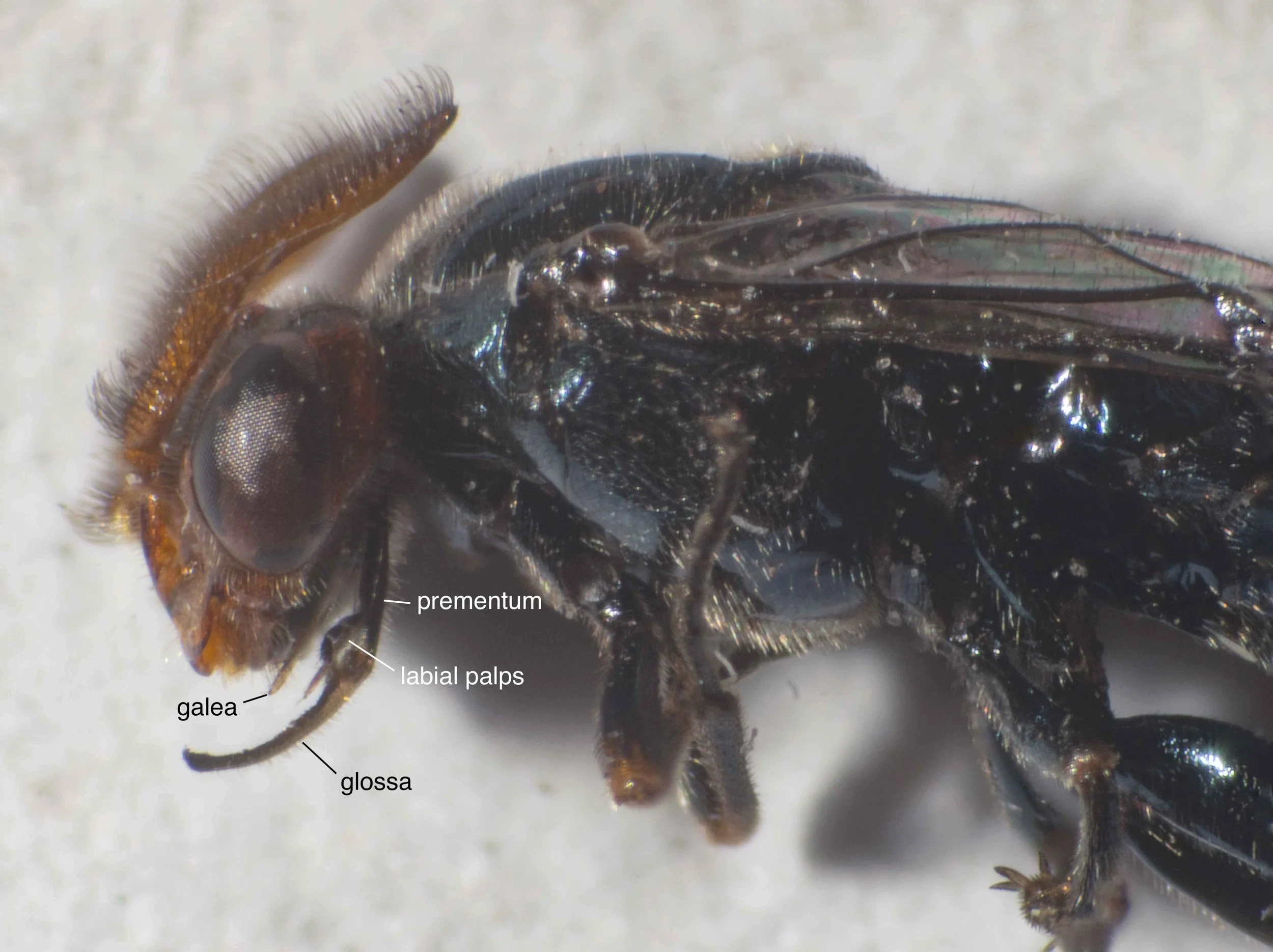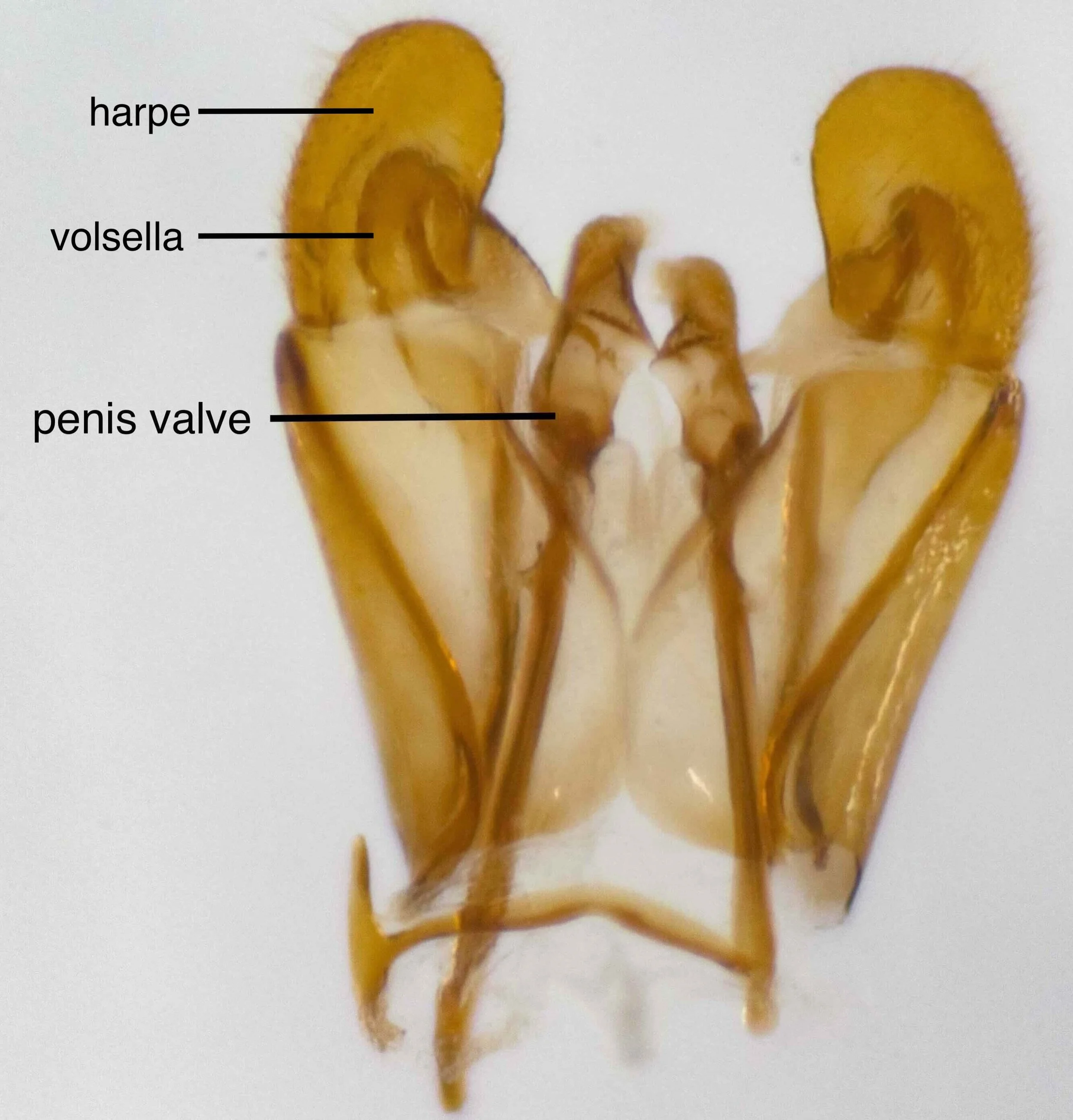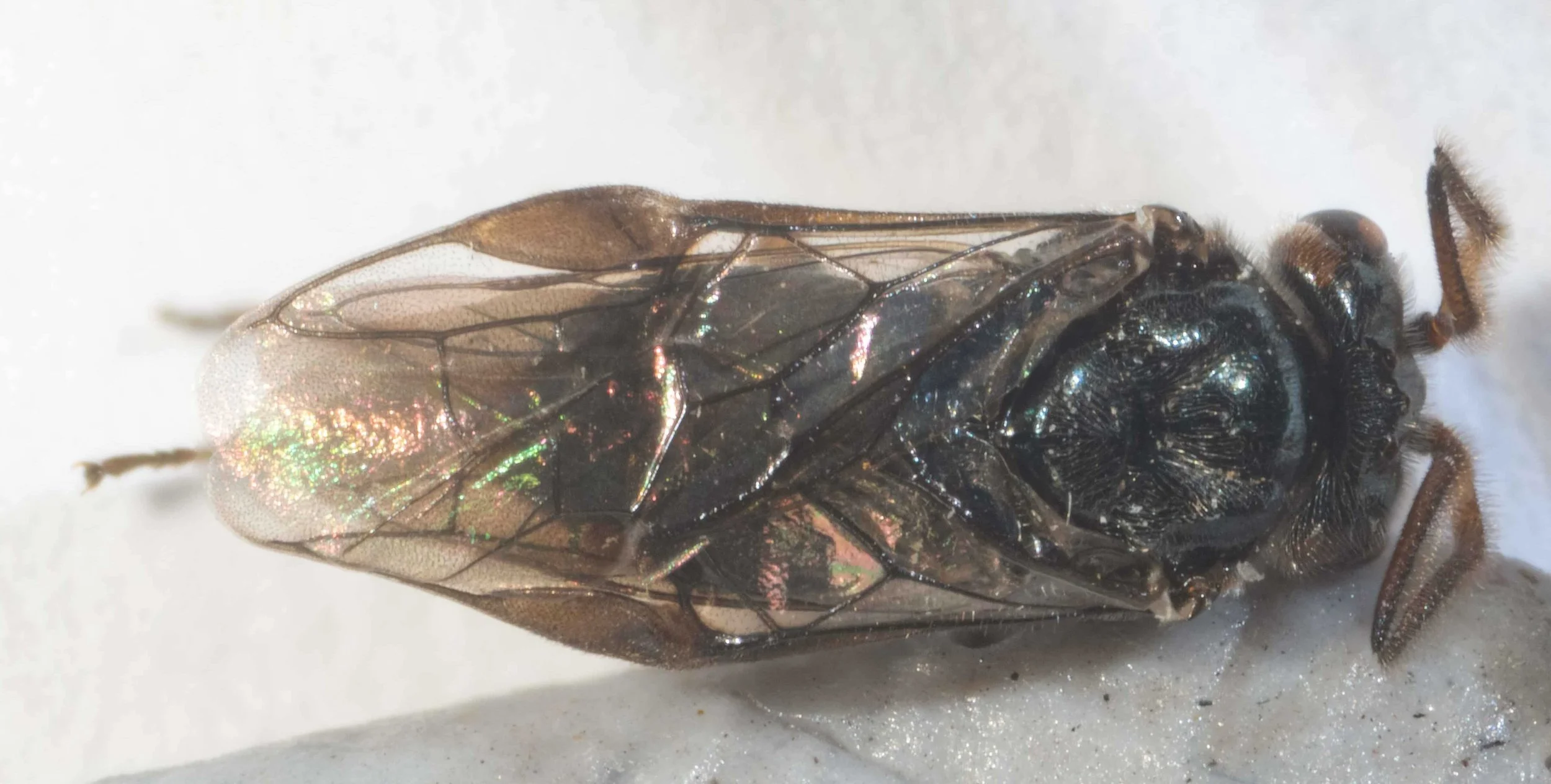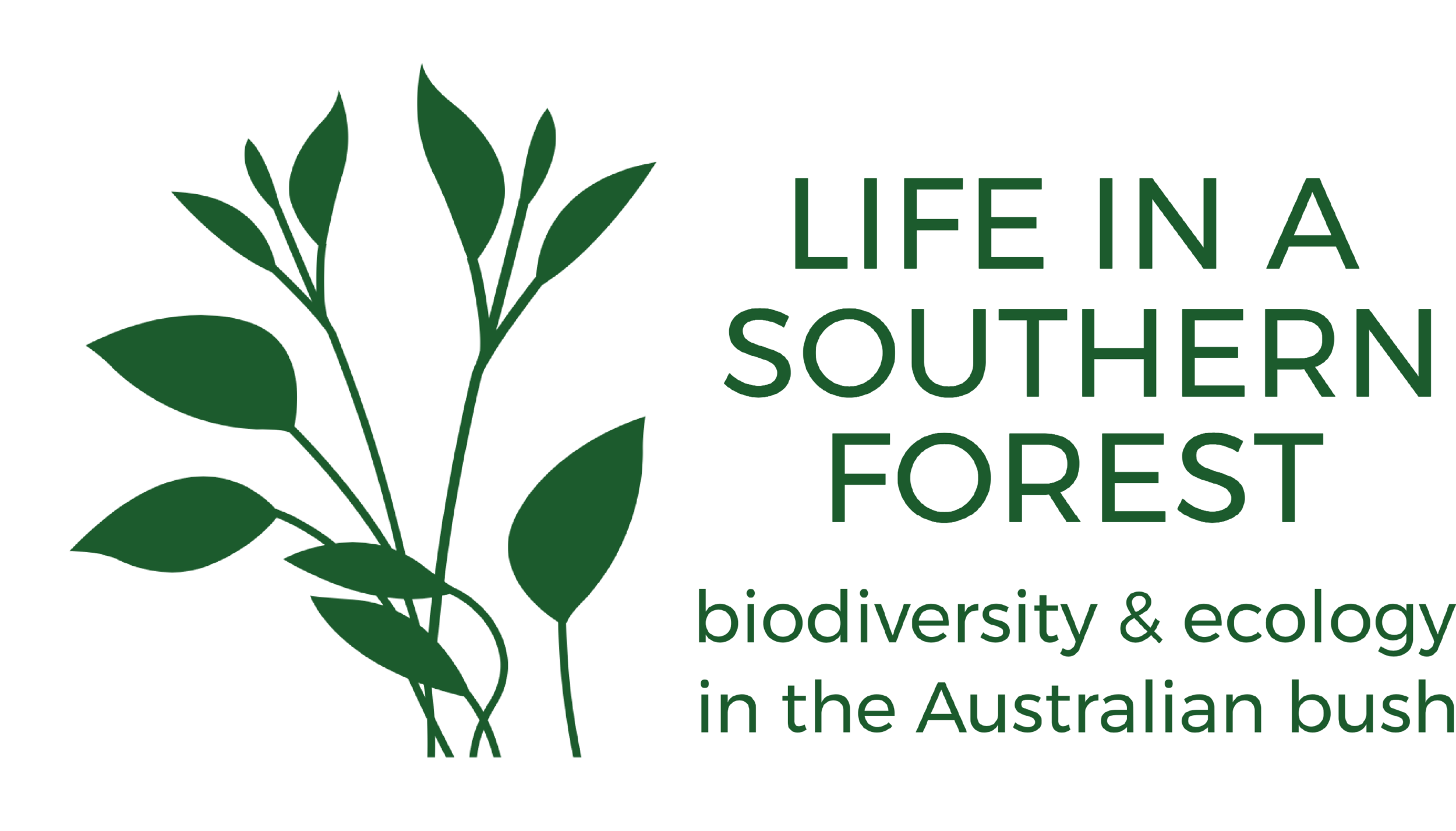
body length 5.0mm
antennae orange, 3 segmented, flagellum bifurcated, setose
whole thorax, abdomen bright metallic blue
all segments of all legs bright metallic blue laterally and dorsally, except joints between femora and tibiae orange
hind basitarsus longer than next 2 tarsal segments together

parts of proboscis shown:
- glossa (tongue), labial palps and prementum parts of labium; glossa longer than prementum, almost same length as eye
- galea, most distal part of maxilla

antennae; 3 segmented, all segments orange; flagellum bifurcated, setose
clypeus, labrum, mandibles and genae orange
glossa (tongue), labial palps and prementum parts of labium; glossa longer than prementum, approx. same length as eye
pronotum, mesonotum and mesopleura bright metallic blue, unpunctured

antennae: 3 segmented, flagellum bifurcated, setose
distance between hind ocelli much greater than distance between ocellus and back of head
vertex black, genae orange
pronotum, mesonotum and scutellum bright metallic blue, unpunctured
forewings hyaline, stigma and venation black; basal vein joins subcosta at a distance from the cubitus almost as great as the length of the 1st transverse cubital vein

labrum, inner orbits, orange
face, ventral side of thorax and abdomen unpunctured
ventral side of thorax and abdomen metallic blue, except for orange apical segment (hypopygium) of abdomen
ventral and anterior side of all segments of all legs black
pre-apical spur on mid and hind tibiae

after removal of mid and hind legs:
labrum, mandibles, all 3 segments of antennae orange
ventral side of thorax and abdomen unpunctured and metallic blue, except for orange apical segment (hypopygium) of abdomen
all segments of fore legs shiny metallic blue, except basal ¼ of tibiae orange

abdomen viewed ventrally:
bright metallic blue, unpunctured
apical segment (hypopygium) orange

dorsal thorax and abdomen after removal of wings and legs
pronotum, mesonotum, scutellum bright metallic blue; unpunctured
abdomen, all terga bright metallic blue except posterior half tergum 1 pale yellow; with coarse transverse wrinkles but unpunctured

rear of abdomen, dorsal view
all terga shining metallic blue; without punctures
orange harpe, tongue-shaped cusps used to grip base of female genitalia during copulation, protruding from rear of body

genitalia dissected from male - close match to drawing of penis valve of T. hyalinus (Fig. 4) in Benson (1938)

genitalia dissected from male - compare to following figures from Benson (1938)

genitalia dissected from male - compare to following figures from Benson (1938)

Male genitalia of Trichorhachus australis - Benson (1938) fig.5

penis valve of Trichorhachus australis (2), T. nitidus (3), T. hyalinus (4) - from Benson (1938), figs. 2-4

hind legs: right leg above, outer surface (coxa missing); left leg below, inner surface, with detached coxa
all segments shiny metallic blue, tibia with a preapical spur
hind basitarsus longer than next 2 tarsal segments

hind legs: right leg on left, inner surface (coxa missing); left leg on right, outer surface, with detached coxa
all segments shiny metallic blue, tibia with a preapical spur
hind basitarsus longer than next 2 tarsal segments together

mid legs: left, inner side of right leg (missing coxa and last 3 tarsomeres); right, lateral side of left leg (missing coxa)
all segments shiny metallic blue, tibia with a preapical spur

mid legs: top, lateral side of right leg (missing last 3 tarsomeres); below, inner side of left leg
all segments shiny metallic blue, tibia with a preapical spur

right foreleg (missing trochanter and coxa) - all segments black, except base and apex of tibia orange

right foreleg (missing coxa) - all segments black, except base and apex of tibia orange

left forewing: hyaline, stigma and venation black; basal vein joins subcosta at a distance from the cubitus almost as great as the length of the 1st transverse cubital vein

left hindwing; hyaline, black veins

body length 4.8mm
antennae 3 segmented, flagellum bifurcated, setose; scape black, pedicel blackish-orange; flagellum basal half orange, apical half blackish-orange
labrum, inner orbits, genae, mandibles (except for black tips) orange
ventral side of thorax and abdomen metallic blue, except for orange apical segment (hypopygium) of abdomen, unpunctured
legs: coxae, ventral side of all legs black; femora, ventral side of all legs black, apex of fore and mid legs orange, apical ¼ of hind legs orange; tibiae and tarsi of all legs orange, apex of hind tibiae blackish, dorsal side of all tarsi blackish
pre-apical spur on mid and hind tibiae

body length 4.9mm
genae orange, vertex black
proboscis shorter than head, glossa shorter than prementum
lateral side of thorax, mesonotum, scutellum and abdomen black; tegula blackish-orange; pronotum black with thin posterior orange rim
legs: all coxae and femora black, except apex of fore and mid femora orange, apical 1/5th hind femora orange; all tibiae and tarsi orange, tarsi somewhat infuscated, especially in fore legs

distance between hind ocelli much greater than distance between ocellus and back of head
vertex black, genae orange
mesoscutum, scutellum bright metallic blue, unpunctured
fore wings hyaline, stigma brown, venation dark brown

anterior abdomen and thorax, viewed dorsally after removal of wings and legs
all terga bright metallic blue, except posterior of tergum 1 pale yellow; unpunctured

antennal flagellum bifurcated, setose; orange , blacked distally
vertex, face black; ventral half of clypeus, labrum, mandibles, inner orbits, genae orange
galea orange, stipes black, palps black; galea shorter than stipes

scape black and orange; pedicel orange; flagellum orange
face, clypeus black; labrum, mandibles, inner orbits, genae orange
galea orange, stipes black, palps black

lateral view of abdomen
all segments bright metallic blue, except for orange apical segment (hypopygium)

lateral view of abdomen and hind legs
all abdominal segments bright metallic blue, except for orange apical segment (hypopygium)
hind coxae and basal ¾ of femora bright metallic blue; tibiae orange

ventral view of abdomen
all segments of venter bright metallic blue, except for orange apical segment (hypopygium); orange harpe, tongue-shaped cusps used to grip base of female genitalia during copulation, protruding from rear of body

genitalia dissected from PW053 - close similarity to drawing of T. nitidus male genitalia in Fig. 19, D-F Malagon-Aldana et al (2021), see Reference images below

genitalia dissected from PW053 - close similarity to drawing of T. nitidus male genitalia in Fig. 19, D-F Malagon-Aldana et al (2021)

Male genitalia of Trichorhachus australis - Benson (1938) fig.5

penis valve of Trichorhachus australis (2), T. nitidus (3), T. hyalinus (4) - from Benson (1938), figs. 2-4

fore wing
hyaline; stigma and venation brown

hind wing
hyaline; stigma and venation brown





































